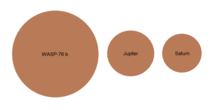How Can We Help?
WASP-76, also known as BD+01 316, is a yellow-white main sequence star in the constellation of Pisces. Since 2014, it has had one suspected stellar companion at a projected separation of 85 astronomical units.[6][7]
Planetary system

The "hot Jupiter" class planet WASP-76b was discovered around WASP-76 in 2013.
| Companion (in order from star) |
Mass | Semimajor axis (AU) |
Orbital period (days) |
Eccentricity | Inclination | Radius |
|---|---|---|---|---|---|---|
| b | 0.92±0.03 MJ | 0.033 | 1.809886±0.000001 | 0 | 88.0±1.6° | 1.83±0.06 RJ |
References
- ^ a b c d e Brown, A. G. A.; et al. (Gaia collaboration) (August 2018). "Gaia Data Release 2: Summary of the contents and survey properties". Astronomy & Astrophysics. 616. A1. arXiv:1804.09365. Bibcode:2018A&A...616A...1G. doi:10.1051/0004-6361/201833051. Gaia DR2 record for this source at VizieR.
- ^ Høg, E.; et al. (2000). "The Tycho-2 catalogue of the 2.5 million brightest stars". Astronomy and Astrophysics. 355: L27–L30. Bibcode:2000A&A...355L..27H.
- ^ Soubiran, C.; Jasniewicz, G.; Chemin, L.; Zurbach, C.; Brouillet, N.; Panuzzo, P.; Sartoretti, P.; Katz, D.; Le Campion, J. -F.; Marchal, O.; Hestroffer, D.; Thévenin, F.; Crifo, F.; Udry, S.; Cropper, M.; Seabroke, G.; Viala, Y.; Benson, K.; Blomme, R.; Jean-Antoine, A.; Huckle, H.; Smith, M.; Baker, S. G.; Damerdji, Y.; Dolding, C.; Frémat, Y.; Gosset, E.; Guerrier, A.; Guy, L. P.; et al. (2018). "Gaia Data Release 2. The catalogue of radial velocity standard stars". Astronomy and Astrophysics. 616: A7. arXiv:1804.09370. Bibcode:2018A&A...616A...7S. doi:10.1051/0004-6361/201832795. S2CID 52952408.
- ^ Martin, Pierre-Yves (2023). "Planet WASP-76 b". exoplanet.eu. Retrieved 2024-01-17.
- ^ a b c West, R. G.; Hellier, C.; Almenara, J.-M.; Anderson, D. R.; Barros, S. C. C.; Bouchy, F.; Brown, D. J. A.; Collier Cameron, A.; Deleuil, M.; Delrez, L.; Doyle, A. P.; Faedi, F.; Fumel, A.; Gillon, M.; Gómez Maqueo Chew, Y.; Hébrard, G.; Jehin, E.; Lendl, M.; Maxted, P. F. L.; Pepe, F.; Pollacco, D.; Queloz, D.; Ségransan, D.; Smalley, B.; Smith, A. M. S.; Southworth, J.; Triaud, A. H. M. J.; Udry, S. (2016). "Three irradiated and bloated hot Jupiters". Astronomy & Astrophysics. 585: A126. arXiv:1310.5607. doi:10.1051/0004-6361/201527276. S2CID 54746373.
- ^ Ngo, Henry; Knutson, Heather A.; Hinkley, Sasha; Bryan, Marta; Crepp, Justin R.; Batygin, Konstantin; Crossfield, Ian; Hansen, Brad; Howard, Andrew W.; Johnson, John A.; Mawet, Dimitri; Morton, Timothy D.; Muirhead, Philip S.; Wang, Ji (2016). "FRIENDS OF HOT JUPITERS. IV. STELLAR COMPANIONS BEYOND 50 au MIGHT FACILITATE GIANT PLANET FORMATION, BUT MOST ARE UNLIKELY TO CAUSE KOZAI–LIDOV MIGRATION". The Astrophysical Journal. 827 (1): 8. arXiv:1606.07102. Bibcode:2016ApJ...827....8N. doi:10.3847/0004-637X/827/1/8. S2CID 41083068.
- ^ Ginski, C.; Mugrauer, M.; Seeliger, M.; Buder, S.; Errmann, R.; Avenhaus, H.; Mouillet, D.; Maire, A.-L.; Raetz, S. (2016). "A lucky imaging multiplicity study of exoplanet host stars – II". Monthly Notices of the Royal Astronomical Society. 457 (2): 2173–2191. arXiv:1601.01524. Bibcode:2016MNRAS.457.2173G. doi:10.1093/mnras/stw049. S2CID 53626523.
- ^ Planet WASP-76 b at exoplanet.eu


Recent Comments